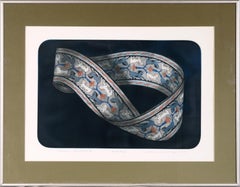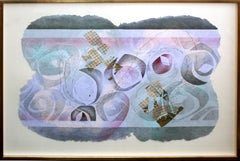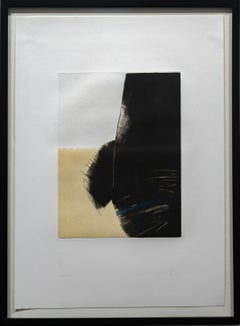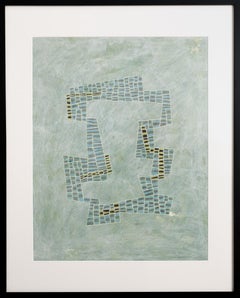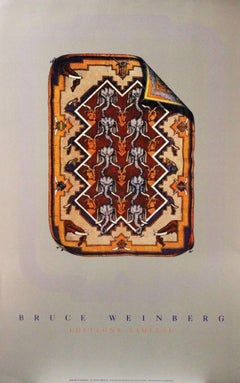Bruce Weinberg Art
American, 1942-1994
Bruce Weinberg was a long time resident of the San Francisco Bay Area. He studied Interior Design at the Philadelphia College of Art and Architectural Space Planning at Temple University. During the 1970s he studied printmaking and drawing at San Francisco's Fort Mason Art Center. His work resides in the permanent collections of museums and corporations.to
1
5
4
1
Overall Width
to
Overall Height
to
10
2
9
1
8
2
9
2
1
1
1
10
8,232
2,807
1,650
1,318
2
10
Artist: Bruce Weinberg
"Unicorn Moebius II" - Trial Proof Lithograph in Ink on Laid Paper
By Bruce Weinberg
Located in Soquel, CA
"Unicorn Moebius II" - Trial Proof Lithograph in Ink on Laid Paper
High contrast, multi-layer etching by Bruce Weinberg (American, 1942-1994). A moebius strip is shown against a dar...
Category
1980s American Modern Bruce Weinberg Art
Materials
Laid Paper, Lithograph
"Crescent Rose" Mixed Media Handmade Paper Watercolor Abstract by Bruce Weinberg
By Bruce Weinberg
Located in Soquel, CA
"Crescent Rose" Mixed Media Handmade Paper Watercolor Abstract by Bruce Weinberg
Soft lavenders, magentas and gray tones highlighted with purple thread and sheets of gold leaf mingle to create a soft and lovely abstract on handmade paper by California artist Bruce Weinberg (American, 1942-1994). Image is floated on a silk background.
Pencil signed and dated "Bruce Weinberg 1980" lower right.
Pencil signed title "Crescent Rose" lower left.
Displayed in a giltwood frame with spacer.
Image size: 24"H x 35"L.
Framed size: 31"H x 43"W x 2"D.
Bruce Weinberg was a long time resident of the San Francisco Bay Area. He studied Interior Design at the Philadelphia College of Art and Architectural Space Planning at Temple University. During the 1970s he studied printmaking and drawing at San Francisco's Fort Mason...
Category
1980s Abstract Geometric Bruce Weinberg Art
Materials
Mixed Media, Handmade Paper
Enclosure
By Bruce Weinberg
Located in San Francisco, CA
This artwork titled "Storm" 1991 is a color etching, with embossing and gold addition on handmade paper by noted artist Bruce Weinberg, 1942-1994 It is hand signed, titled, numbered ...
Category
Late 20th Century American Modern Bruce Weinberg Art
Materials
Mixed Media
Palladio
By Bruce Weinberg
Located in San Francisco, CA
This artwork titled "Palladio" 1991 is a color etching, with embossing and gold addition on handmade paper, with deckle edge, by noted artist Bruce Weinberg, 1942-1994 It is hand sig...
Category
Late 20th Century American Modern Bruce Weinberg Art
Materials
Mixed Media
Cascade
By Bruce Weinberg
Located in San Francisco, CA
This artwork titled "Cascade" 1991 is a color etching, with embossing and gold addition on handmade paper by noted artist Bruce Weinberg, 1942-1994 It is hand signed, titled, numbere...
Category
Late 20th Century American Modern Bruce Weinberg Art
Materials
Mixed Media
Romanesque
By Bruce Weinberg
Located in San Francisco, CA
This artwork titled "Romanesque" 1991 is a color etching, with embossing and gold addition on handmade paper, with deckle edge, by noted artist Bruce Weinberg, 1942-1994 It is hand signed, titled, numbered 20/50 and dated in pencil by the artist. The size is 38 x 27 inches. It is in excellent condition.
About the artist.
Bruce Weinberg (1942-1994) studied Interior Design at the Philadelphia College of Art and Architectural Space Planning at Temple University. During the 1970's he studied printmaking and drawing at San Francisco's Fort Mason Art Center. He created limited edition etchings as well as monoprints on his handmade paper. He was best known for multi-plate color hand pulled etchings of rugs and tapestries, which appear three dimensional with folds, fringes and turned up corners. Etchings were executed by use of traditional hard and soft ground etching technique. Employing multiple copper etching...
Category
Late 20th Century American Modern Bruce Weinberg Art
Materials
Mixed Media
Aero
By Bruce Weinberg
Located in San Francisco, CA
This artwork titled "Aero" 1990 is a color etching, with embossing and gold addition on handmade paper, with deckle edge, by noted artist Bruce Weinberg, 1942-1994 It is hand signed,...
Category
Late 20th Century American Modern Bruce Weinberg Art
Materials
Mixed Media
Golden Sails
By Bruce Weinberg
Located in San Francisco, CA
This artwork titled "Golden Sails" 1991 is a color etching, with embossing and gold addition on handmade paper by noted artist Bruce Weinberg, 1942-1994 It is hand signed, titled, nu...
Category
Late 20th Century American Modern Bruce Weinberg Art
Materials
Mixed Media
Storm
By Bruce Weinberg
Located in San Francisco, CA
This artwork titled "Storm" 1991 is a color etching, with embossing on handmade paper by noted artist Bruce Weinberg, 1942-1994 It is hand signed, titled, numbered 20/50 and dated i...
Category
Late 20th Century American Modern Bruce Weinberg Art
Materials
Mixed Media
Savared
By Bruce Weinberg
Located in San Francisco, CA
This artwork titled "Savared" 1991 is a color etching, with embossing and gold addition on handmade paper by noted artist Bruce Weinberg, 1942-1994 It is hand signed, titled, numbere...
Category
Late 20th Century American Modern Bruce Weinberg Art
Materials
Mixed Media
Related Items
Douglas Semivan Print "Abstract in Gold and Black"
By Douglas Semivan
Located in Detroit, MI
"Abstract in Gold and Black" is a well-balanced calm piece. The placement of the gold and white can be read as a distant landscape giving much imagined space to the heavier black area which contains a linear element and the color blue. Semivan is a Master Printmaker and sculptor. He often breaks his surfaces and extends beyond the perimeters in his sculptures. The particular placement of the black area in this piece suggests such a breakage beyond the edge where one imagines a continuation of the strokes or linear elements. This is an altogether extraordinary print.
Born in Detroit, Michigan, Douglas Semivan...
Category
Late 20th Century American Modern Bruce Weinberg Art
Materials
Paper, Printer's Ink
$2,900
H 31 in W 23.25 in
Blue & Grey Green Plan: Abstract Geometric Framed Painting in Cool Toned Palette
By Donise English
Located in Hudson, NY
Abstract geometric painting with a cool toned palette of green, blue, and grey with accents of black and white against a sea foam green colored acrylic wash background
"Blue and Grey Green Plan" made by Hudson Valley artists, Donise English, in 2022
Graphite, colored pencil, and acrylic painting on vellum
24 x 18 inches unframed, 31 x 25 x 1.5 with an 8-ply white mat, non-glare plexi, and simple black moulding
Signed, verso
Excellent condition and ready to hang
This abstract geometric painting on vellum was made by Hudson Valley based artist, Donise English, in 2022. The composition begins with a blue green toned background of acrylic wash. A grid of box-like patterns in sky blue, green, grey, and black with white line work are stacked to create an irregular shape or an "imagined city grid", says the artist. The painting on vellum is complemented by a simple black frame with an 8-ply white mat, non-glare plexi, and wire backing. It's in excellent condition and ready to hang.
About the artist:
Donise English emphasizes lines, grids, and fields of subtle color to evoke imagined places and invented structures. While precise lines and straight angles are often associated with themes in architecture and urban planning designs, English conveys a geometric motif guided by intuition rather than a ruler. Variations on grids retain flaws and unmistakable traces of the artists’ hand; her style of draftsmanship shies away from intellectualism and instead makes her compositions feel very personal. A central checkerboard formation floats over a ground of pastel color or washes of grey or cream. Each design is intensely intricate, incorporating gouache, acrylic, pen, graphite, ink and colored pencil. The artist recently retired from her decades career teaching at Marist College and is now devoted full time to her art making.
Artist Statement:
My work is about the way visual diagrams present information that describes how something is made or the way it is. I am interested in drawing and collaging multiple layers of information that refer abstractly to maps, architectural drawings and blueprints or patterns and structures found in such things as roller coasters, power lines and fences. I use gouache and collaged paper in a series of layers that are a visual and ideological response to the previous layer to define my pictorial space. For each piece I create a set of rules to follow about the use of a limited palette, a grid format, opacity of paper and whether a piece may include curving lines or maintain a rectilinear structure.
Artist CV:
EDUCATION
Master of Fine Arts in Painting
Bard College 1986
Bachelor of Science in Art History
State University College at New Paltz 1977
Additional Study: New York Studio School (Drawing Marathons)
Columbia University, School of Architecture
Women’s Studio Workshop
TEACHING
Professor of Studio Art, Department of Art and Art History, Marist College, Poughkeepsie, NY
Coordinator, Interior Design Program, Florence, Italy campus
1992-present
AWARDS
NYFA Fellowship in Painting 2018
Invitational Award for Outstanding Contemporary Talent,
University of Bridgeport, CT 2000
Purchase Prize, “11th National Juried Exhibition”
College of Notre Dame of Maryland, Baltimore 1999
First Prize, “Women in the Visual Arts ‘95”
Erector Square Gallery, New Haven, CT 1995
Joseph A. Cain Memorial Purchase Award for Sculpture
Del Mar College, Corpus Christi, TX 1994
Honorable Mention, “National Juried Exhibition”
University of Bridgeport, CT 1993
Individual Artists Fellowship in Sculpture
Dutchess Arts Fund 1992/93
Tallix, Morris, Singer Internship in Sculpture
Tallix Foundry, Beacon, NY 1990/91
MEMBERSHIP Royal British Society of Sculptors
SELECTED JURIED/INVITATIONAL EXHIBITIONS
2020
“edu: Art Faculty of the Hudson Valley”, Hudson Valley MOCA, Peekskill, NY
2019
“Contemporary Abstraction”, Carrie Haddad Gallery, Hudson, NY
“Mixed Media”, SITE Gallery, Brooklyn, NY
2018
“JuxtaPositions”, The Painting Center, New York, NY
“Peculiar Rarities”, Carrie Haddad Gallery, Hudson, NY
2017
“Interlock: Color and Contrast in Abstraction”, Carrie Haddad Gallery, Hudson, NY
“Donise English: Encaustics”, Catskill Art Society, Livingston Manor, NY
2016
“Let’s Stay in Touch”, Howard County Center for the Arts, Ellicott City, MD
“Under, Over, After Over”, Vassar College, Poughkeepsie, NY
2015
“Off the Grid”, Arts & Culture Program, Albany International Airport, Albany, NY
“Gridspace”, KMOCA, Kingston, NY
“Abstraction”, Carrie Haddad Gallery, Hudson, NY
“Assuming Identity”, NY Institute of Technology, New York, NY
2013
“Modern Artists”, Carrie Haddad Gallery, Hudson, NY
“Artists of the Mohawk-Hudson Region”, The Hyde Collection, Glens Falls, NY
Stone Canoe/Community Folk Art Center, Syracuse, NY
2012
New York Institute of Technology, New York, NY
“Contemporary Painters (Who Just Happen To Be Women)”,
Carrie Haddad Gallery, Hudson, NY
“Strange Glue: Collage at 100”, Cambridge School, Weston, MA
“Dear Mother Nature”, Dorsky Museum, SUNY New Paltz, NY
“Fresher Paint”, Rockland Center for the Arts, Nyack, NY
Courthouse Gallery, Lake George Arts Project, Lake George, NY
2011
“Process+Content: Donise English”, Vassar College, Poughkeepsie, NY “Donise English-Paintings”,Orange County Community College,
Newburgh, NY
“Gender Matters/Matters of Gender”, Freedman Gallery,
Albright College, Reading, PA
2010
Carrie Haddad Gallery, Hudson, NY
“Encaustics: Wax and Image”, Westchester Community College,
White Plains, NY
“Dots, Lines and Figures”, Carrie Haddad Gallery, Hudson, NY
“Spring Awakening”, NY Institute of Technology, New York, NY
“Clay City Dreams”, NY Institute of Technology, New York, NY
“Texture,Pattern, Fragment”, Krause Gallery, Moses Brown School,
Providence, RI
2009
“Collage”, NY Institute of Technology, New York, NY
“Working in Wax”, Bedford Gallery, Walnut Creek, CA
“Encaustic 2009”, College of New Rochelle, NY
“Three Artists”, Carrie Haddad Gallery, Hudson, NY
“Convergence: The Human Experience”,Howard County Center for the Arts, MD
2008
“Suckers and Biters: Love, Lollipops, and Exquisite Corpse”
Chashama Gallery, New York, NY
Carrie Haddad Gallery, Hudson NY
2007
“Patterns and Light”, Blue Hill Gallery, Blue Hill, ME
“Suckers and Biters”, AG Gallery, Brooklyn, NY
2006
“100 Artists, 100 Watercolors”, Jeannie Freilich Fine Art,
New York, NY
“On/Of Paper”,Kirkland Art Center, Clinton, NY
“The Love Show”, Manchester Community College, Manchester, CT
2005
The Soap Factory, Minneapolis, MN
“Small Tales”, Valdosta State University, Georgia
National Juried Exhibition,Art Institute and Gallery
Salisbury, MD, Juror: Stephen Haller
“Greed, Envy, Jealousy, Fear”, TSL Warehouse, Hudson, NY
2004
“Women in the Middle: Borders, Barriers, Intersections”
University of Wisconsin-Milwaukee
“Girl Art Now”,Hera Gallery, Wakefield, RI
3 Person Exhibition, Monterey Peninsula College, Monterey, CA
“The Feminine Eye”, Bradley University, Peoria, IL “Women Painting Women”, McNeese State University, Lake Charles, LA “Thought Patterns”, Kent Place Gallery, Summit, NJ “Surface, Matter and Artifice”, Dutchess Community College Art Gallery
Poughkeepsie, NY
2003
“Beefcake/Cheesecake”,Orange County Center for Contemporary Art,
Santa Ana, CA,Juror: Jamie Wilson, Curator
Halpert Bienniel, Appalachian State University, Boone, NC
Juror: Jeff Fleming, Senior Curator, Des Moines Art Center “The Great White Oak”, Garrison Art Center, Garrison, NY Carrie Haddad Gallery, Hudson, NY
2002
“Cat Calls”, Red Clay Arts, Brooklyn
“Hudson Valley Regional”, SUNY New Paltz
Juror: Sydney Jenkins, Director, Ramapo College Art Galleries
2001
One-Person Exhibition, Davis and Hall Gallery, Hudson, NY “Beyond the Surface”, Womanmade Gallery, Chicago
One-Person Exhibition, Garrison Art Center, Garrison, NY
2000
“Vision 2000...
Category
2010s Abstract Geometric Bruce Weinberg Art
Materials
Canvas, Gouache, Archival Paper, Color Pencil, Graphite
Donise EnglishBlue & Grey Green Plan: Abstract Geometric Framed Painting in Cool Toned Palette, 2020
$3,200
H 31 in W 25 in D 1.5 in
The Fan
By Leonard Pytlak
Located in Fairlawn, OH
The Fan
Silkscreen printed in colors, 1950's
Signed and numbered in pencil by the artist (see photos)
Edition: 40 (24/40)
Condition: very good
Image size: 25 1/8 x 19 5/8 inches
Cou...
Category
1950s American Modern Bruce Weinberg Art
Materials
Screen
Colorful painting on paper, Unique piece, Abstract Expressionist
Located in Carballo, ES
TUSET (1997, A Coruña, España)
Mixed media painting on paper
Ready to frame
One-of-a-kind
Signed on back
Includes certificate of authenticity
2021
65 x 50 cm.
It belongs to the ser...
Category
21st Century and Contemporary Abstract Geometric Bruce Weinberg Art
Materials
Paper, Oil Crayon, Ink, Mixed Media, Acrylic, Pencil
$720
H 65 in W 50 in D 0.2 in
Late 20th century color lithograph prairie style Frank Lloyd Wright architecture
By Frank Lloyd Wright
Located in Milwaukee, WI
"The Prairie School Collection - Rug" is an offset lithograph poster with gold foil. This piece advertises an exhibition of Frank Lloyd Wright's designs. Unsigned.
34 7/8" x 22" art...
Category
1980s American Modern Bruce Weinberg Art
Materials
Offset
'Blue Fish', Musee National d'Art Moderne, Grand Prix de Rome, Salon d'Automne
By Roger Bezombes
Located in Santa Cruz, CA
Signed lower left, 'Roger Bezombes' (French, 1913-1994) and titled, 'Poisson bleu' with number and limitation, lower right, '25/150'.
Roger Bezombes first attended the Ècole des Beaux-Arts (1934) and was the recipient of numerous prizes, medals and juried awards including the Grand Prix de Rome...
Category
1970s Modern Bruce Weinberg Art
Materials
Paper, Lithograph
Elephant, Lions Bold Color Lithograph Alexander Calder Unfinished Revolution
By Alexander Calder
Located in Surfside, FL
1975 Color Lithograph by Alexander Calder
from Our Unfinished Revolution portfolio
One of 250 copies, with the printed signature and date on offset paper.
This is not pencil signed ...
Category
1970s American Modern Bruce Weinberg Art
Materials
Lithograph
Hand Colored Etching by WPA Artist Agnes Mills, 1982, Unique
Located in New York, NY
Agnes Mills (American, 1915-2008)
Guignol Intermezzo, 1982
Hand colored etching (UNIQUE)
Sight: 13 3/4 x 11 1/4 in.
Framed: 19 1/2 x 17 x 3/4 in.
Titled lower right
Inscribed "AP" bo...
Category
1980s American Modern Bruce Weinberg Art
Materials
Etching
$750
H 19.5 in W 17 in D 0.75 in
Untitled (Plate 1) DLM
By Alexander Calder
Located in Fairlawn, OH
Untitled (Plate 1) DLM
Color lithograph, 1963
Unsigned and unnumbered (as usual)
From: Derriere le Miroir, No. 141
Published by A. Maeght, Paris
Image/sheet size: 14 7/8 x 11 inches...
Category
1960s American Modern Bruce Weinberg Art
Materials
Lithograph
Things Kept
Located in Fairlawn, OH
Things Kept
Color lithograph, 1970
Signed & titled in pencil (see photos)
Annotated: "Artists Proof"
Printed on RIVES wove paper
Condition: Excellent
Sheet has aging consistent with ...
Category
1970s American Modern Bruce Weinberg Art
Materials
Lithograph
Untitled (Plate 2) DLM
By Alexander Calder
Located in Fairlawn, OH
Untitled (Plate 2) DLM
Color lithograph, 1963
Unsigned and unnumbered (as issued)
From: Derriere le Miroir, No. 141
Published by A. Maeght, Paris
Printer: Mourlot Freres, Paris
Note...
Category
1960s American Modern Bruce Weinberg Art
Materials
Lithograph
Air France, Mediterranee by Roger Bezombes
By Roger Bezombes
Located in New York, NY
This lithographic poster was printed in 1981 at the Atelier Mourlot in Paris.
In the early 1970s, Air France commissioned Roger Bezombes to create original artworks capturing the s...
Category
1980s Modern Bruce Weinberg Art
Materials
Lithograph
Previously Available Items
Poster-Editions Limited. Limited Galleries, Indianapolis/San Francisco
By Bruce Weinberg
Located in Chesterfield, MI
BRUCE WEINBERG (American, 1942-1994). Poster-Editions Limited, 1980. Measures 39 x 25 inches Unframed. Publishing Information: Limited Galleries, Indianapolis/San Francisco. Fair/Dis...
Category
1980s Bruce Weinberg Art
Materials
Lithograph
Lifes Tapestry
By Bruce Weinberg
Located in San Francisco, CA
This artwork titled "Lifes Tapestry" 1978 is a color etching with aquatint on creme Arches paper by noted artist Bruce Weinberg, 1942-1994. It is hand signed, titled, dated and numbe...
Category
Late 20th Century American Modern Bruce Weinberg Art
Materials
Aquatint
Navajo Suite I
By Bruce Weinberg
Located in San Francisco, CA
This artwork titled "Navajo Rug I" 1978 is a color etching, with embossing on Wove paper by noted artist Bruce Weinberg, 1942-1994. It is hand signed, titled, inscribed A.P and dated...
Category
Late 20th Century American Modern Bruce Weinberg Art
Materials
Mixed Media
Alhambra II
By Bruce Weinberg
Located in San Francisco, CA
This artwork titled "Alhambra II" 1989 is a color etching, with embossing and gold addition on handmade paper, with deckle edge, by noted artist Bruce Weinberg, 1942-1994 It is hand signed, titled, numbered 11/125 and dated in pencil by the artist. The size is 39 x 28 inches. It is in excellent condition.
About the artist.
Bruce Weinberg (1942-1994) studied Interior Design at the Philadelphia College of Art and Architectural Space Planning at Temple University. During the 1970's he studied printmaking and drawing at San Francisco's Fort Mason Art Center. He created limited edition etchings as well as monoprints on his handmade paper. He was best known for multi-plate color hand pulled etchings of rugs and tapestries, which appear three dimensional with folds, fringes and turned up corners. Etchings were executed by use of traditional hard and soft ground etching technique. Employing multiple copper etching plates...
Category
Late 20th Century American Modern Bruce Weinberg Art
Materials
Mixed Media
Bruce Weinberg art for sale on 1stDibs.
Find a wide variety of authentic Bruce Weinberg art available for sale on 1stDibs. You can also browse by medium to find art by Bruce Weinberg in mixed media, handmade paper, paper and more. Much of the original work by this artist or collective was created during the 20th century and is mostly associated with the modern style. Not every interior allows for large Bruce Weinberg art, so small editions measuring 22 inches across are available. Customers who are interested in this artist might also find the work of Ed Baynard, Roman Cieslewicz, and Judith Rothchild. Bruce Weinberg art prices can differ depending upon medium, time period and other attributes. On 1stDibs, the price for these items starts at $1,100 and tops out at $1,440, while the average work can sell for $1,250.
